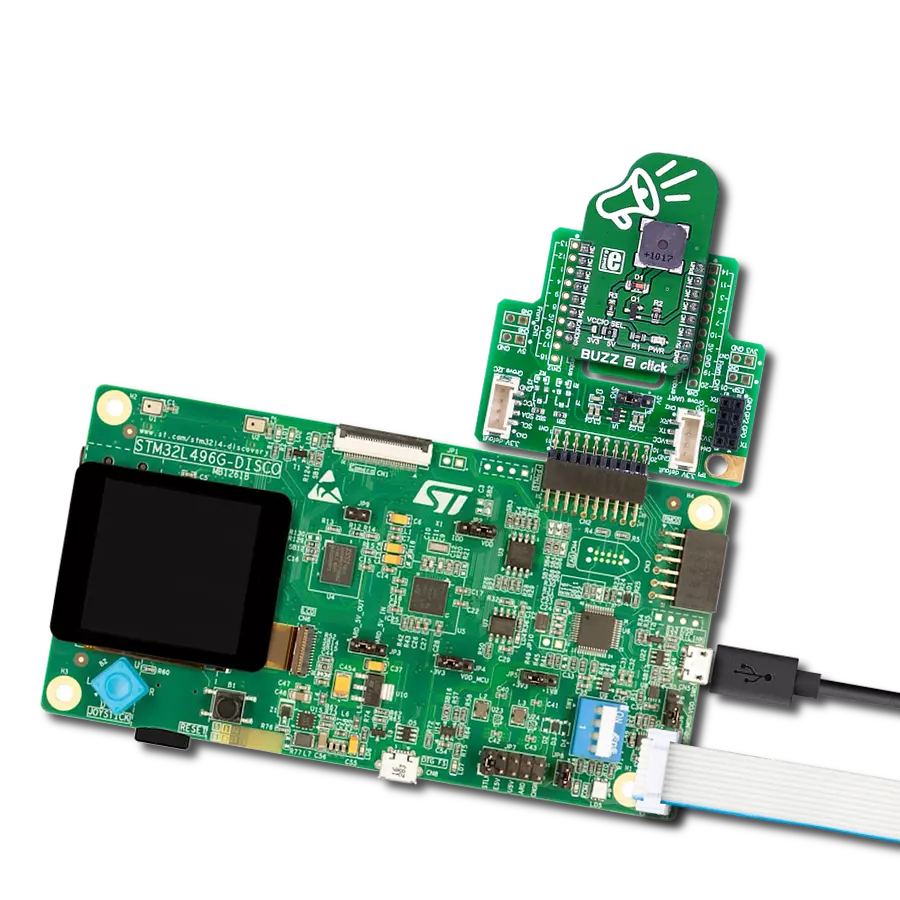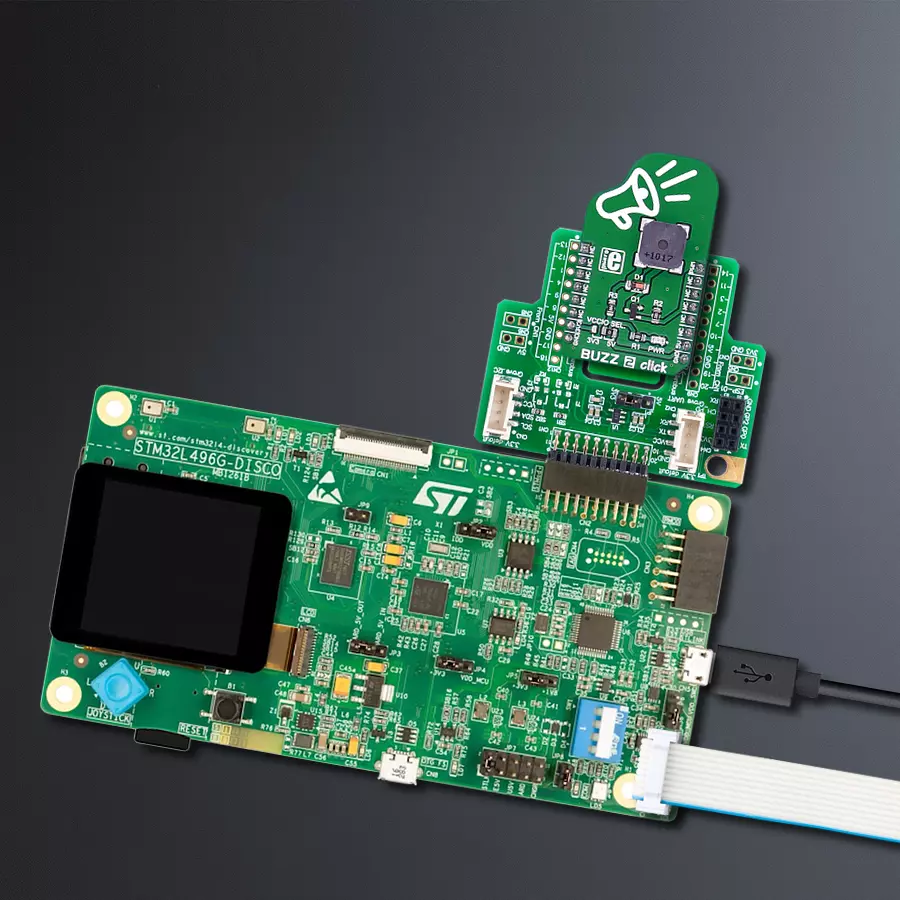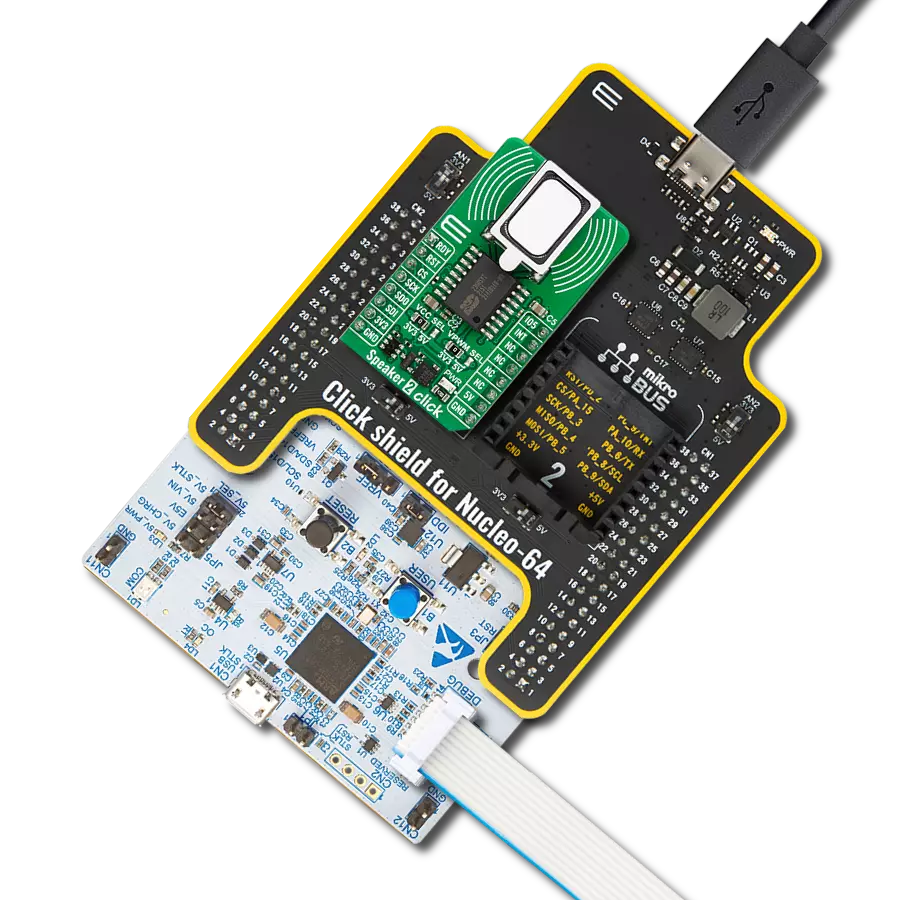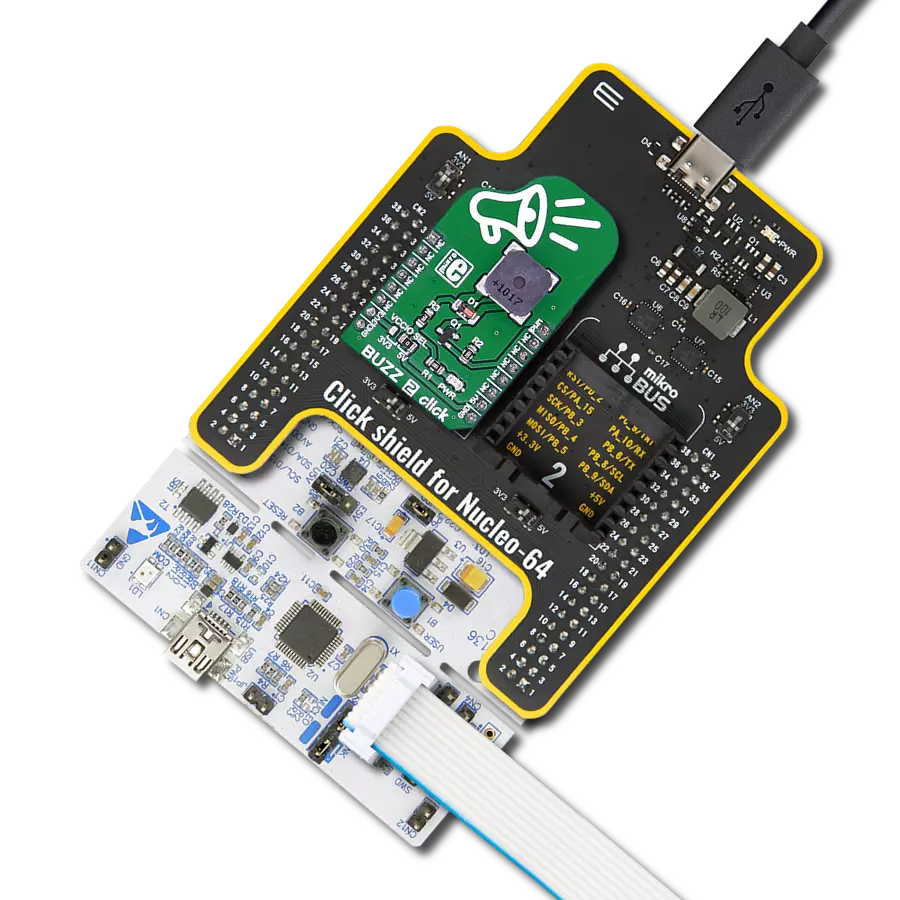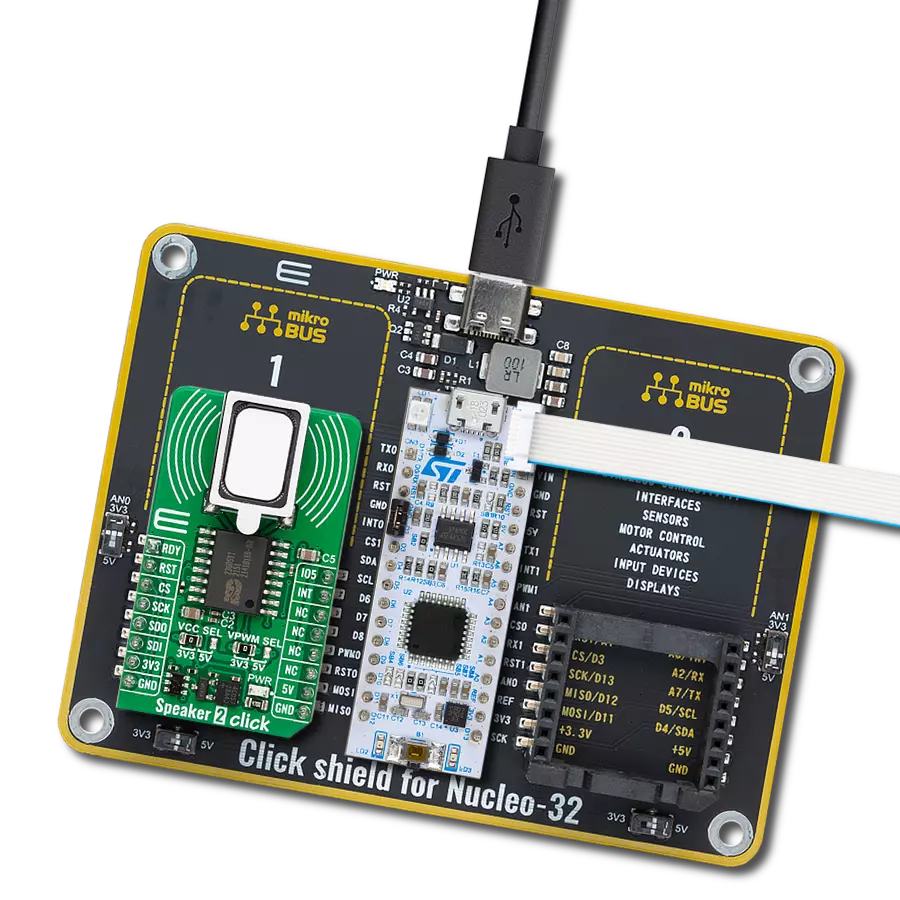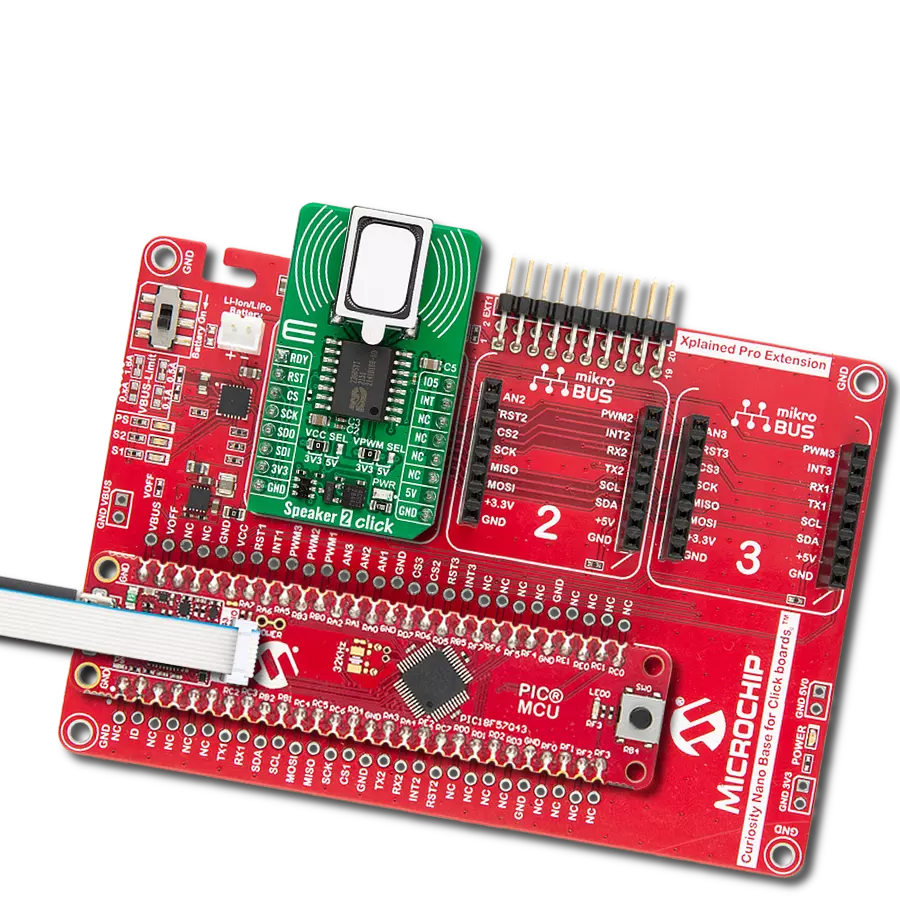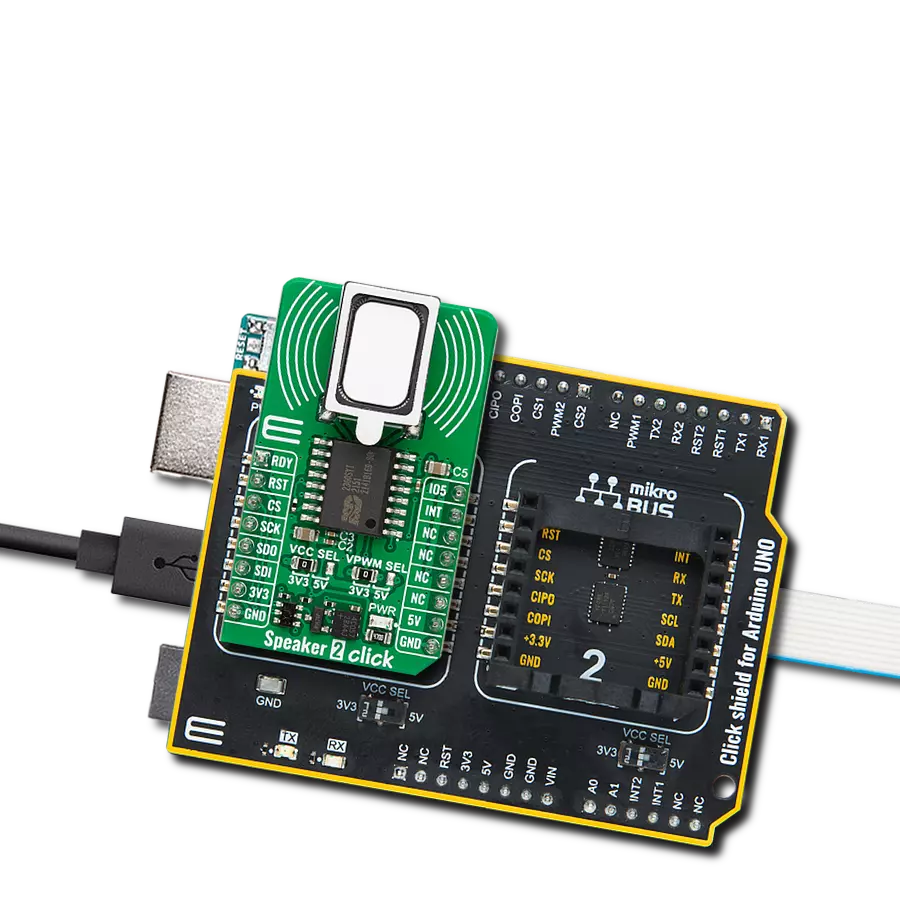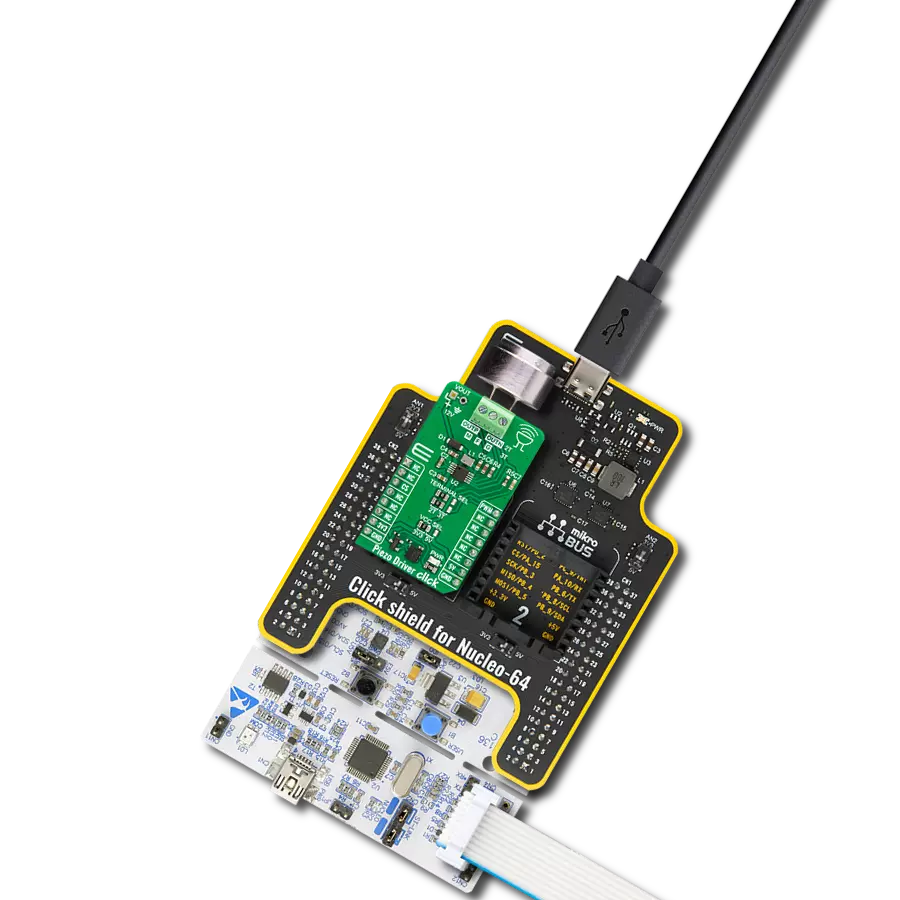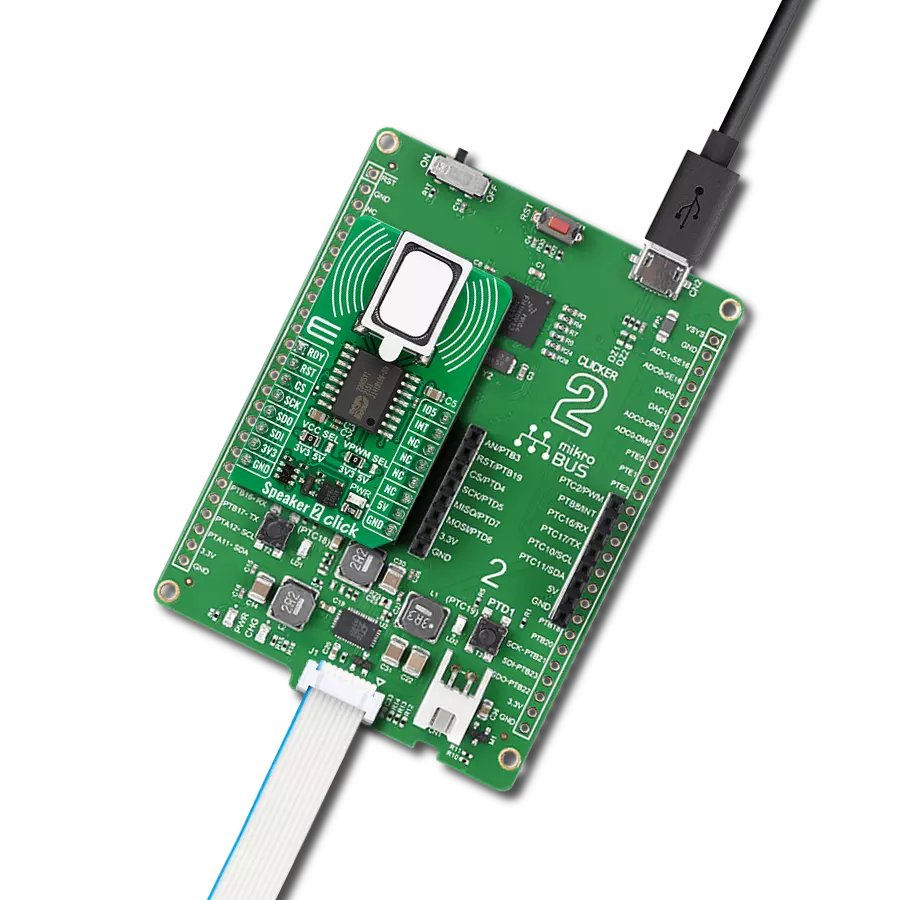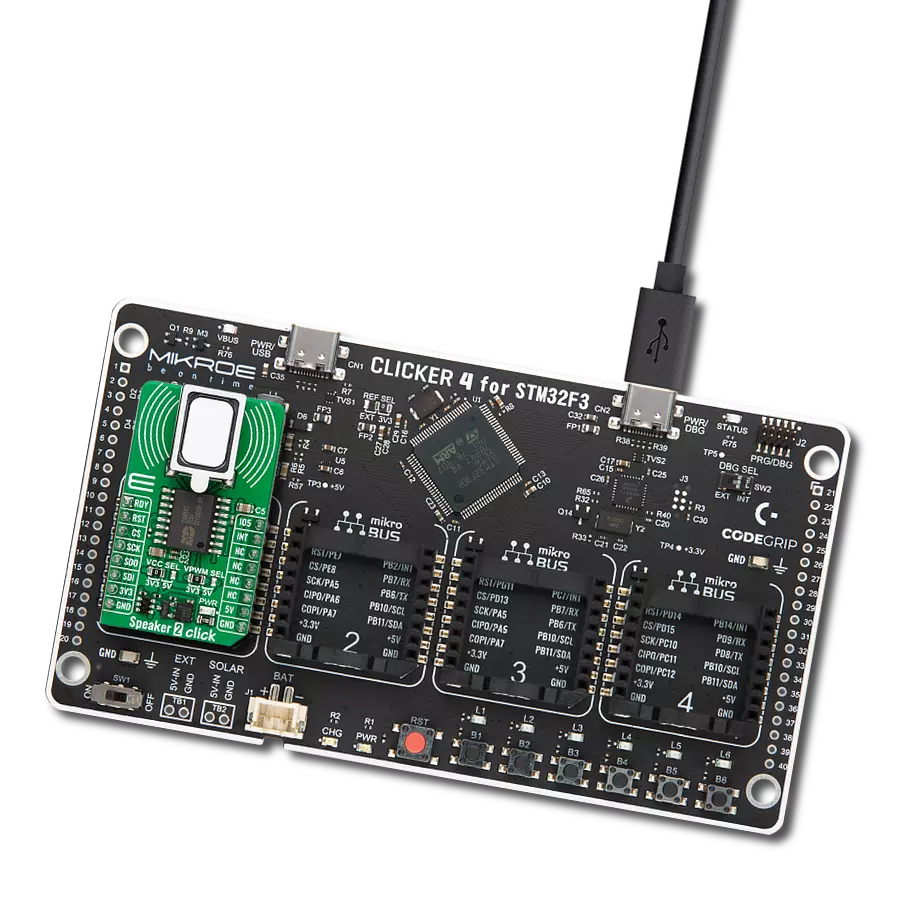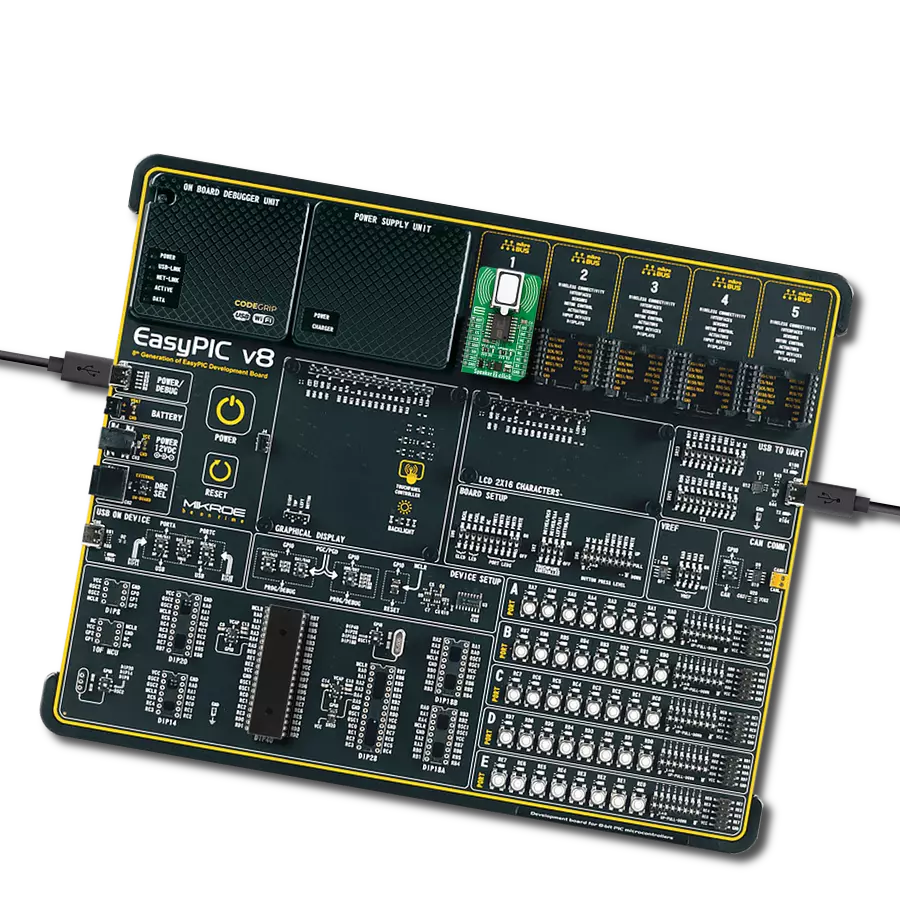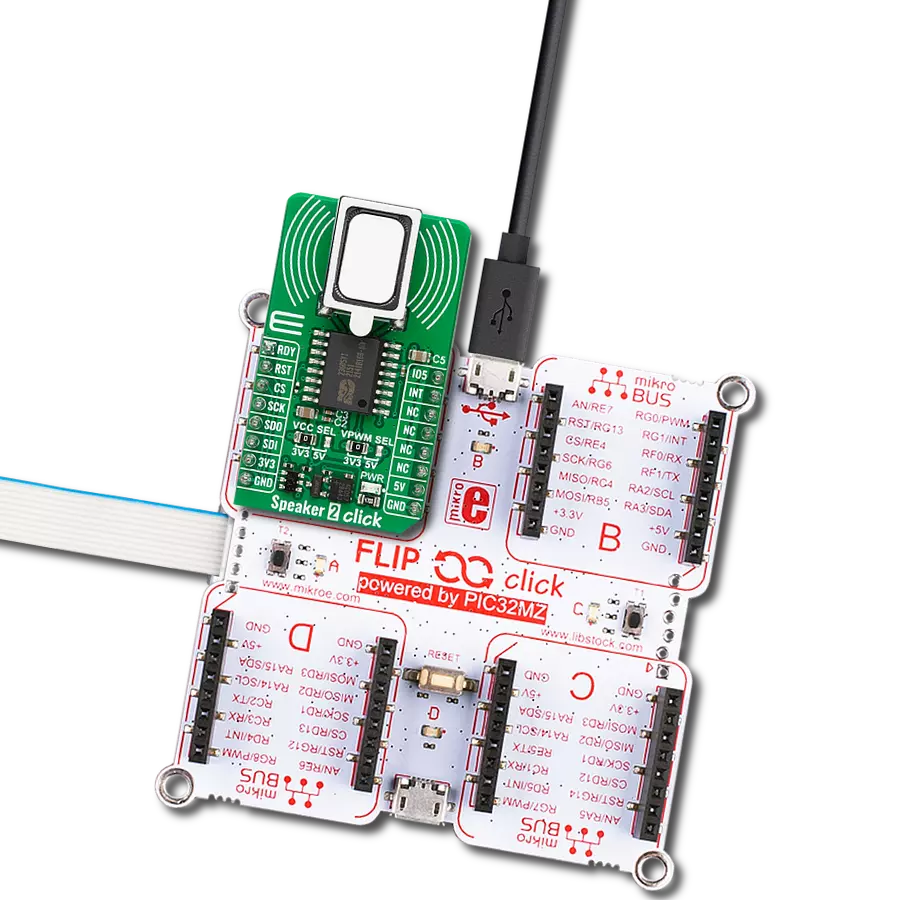探索我们的蜂鸣器解决方案如何彻底改变您的日常生活,从增强家庭安全到简化工业流程。
A
A
硬件概览
它是如何工作的?
BUZZ 2 Click基于CMT-8540S-SMT,这是来自CUI Devices的磁性蜂鸣器换能器。蜂鸣器的共振频率为4kHz。该点击板设计为可以使用3.3V或5V电源运行。mikroBUS™线上的PWM引脚控制CMT-8540S-SMT磁性蜂鸣器。您可
以使用我们编译器支持的Sound库来创建不同的声音模式,或利用微控制器内部的PWM模块来为蜂鸣器创建信号。信号频率决定声音的音调,而占空比决定振幅(声音大小)。这个Click board™可以通过VCCIO SEL跳线选择使
用3.3V或5V逻辑电压级别,这样,3.3V和5V能力的MCU都可以正确使用通信线。此外,这个Click board™还配备了一个包含易于使用的功能和示例代码的库,可以作为进一步开发的参考。
功能概述
开发板
32L496GDISCOVERY Discovery 套件是一款功能全面的演示和开发平台,专为搭载 Arm® Cortex®-M4 内核的 STM32L496AG 微控制器设计。该套件适用于需要在高性能、先进图形处理和超低功耗之间取得平衡的应用,支持无缝原型开发,适用于各种嵌入式解决方案。STM32L496AG 采用创新的节能架构,集成
了扩展 RAM 和 Chrom-ART 图形加速器,在提升图形性能的同时保持低功耗,使其特别适用于音频处理、图形用户界面和实时数据采集等对能效要求较高的应用。为了简化开发流程,该开发板配备了板载 ST-LINK/V2-1 调试器/编程器,提供即插即用的调试和编程体验,使用户无需额外硬件即可轻松加载、调
试和测试应用程序。凭借低功耗特性、增强的内存能力以及内置调试工具,32L496GDISCOVERY 套件是开发先进嵌入式系统、实现高效能解决方案的理想选择。
微控制器概述
MCU卡片 / MCU

建筑
ARM Cortex-M4
MCU 内存 (KB)
1024
硅供应商
STMicroelectronics
引脚数
169
RAM (字节)
327680
使用的MCU引脚
mikroBUS™映射器
“仔细看看!”
Click board™ 原理图

一步一步来
项目组装
实时跟踪您的结果
应用程序输出
1. 应用程序输出 - 在调试模式下,“应用程序输出”窗口支持实时数据监控,直接提供执行结果的可视化。请按照提供的教程正确配置环境,以确保数据正确显示。

2. UART 终端 - 使用UART Terminal通过USB to UART converter监视数据传输,实现Click board™与开发系统之间的直接通信。请根据项目需求配置波特率和其他串行设置,以确保正常运行。有关分步设置说明,请参考提供的教程。

3. Plot 输出 - Plot功能提供了一种强大的方式来可视化实时传感器数据,使趋势分析、调试和多个数据点的对比变得更加直观。要正确设置,请按照提供的教程,其中包含使用Plot功能显示Click board™读数的分步示例。在代码中使用Plot功能时,请使用以下函数:plot(insert_graph_name, variable_name);。这是一个通用格式,用户需要将“insert_graph_name”替换为实际图表名称,并将“variable_name”替换为要显示的参数。

软件支持
库描述
这个库包含了BUZZ 2 Click驱动的API。
关键功能:
buzz2_set_duty_cycle- BUZZ 2设置PWM占空比buzz2_play_sound- 播放声音功能buzz2_pwm_start- BUZZ 2启动PWM模块
开源
代码示例
完整的应用程序代码和一个现成的项目可以通过NECTO Studio包管理器直接安装到NECTO Studio。 应用程序代码也可以在MIKROE的GitHub账户中找到。
/*!
* @file main.c
* @brief Buzz2 Click example
*
* # Description
* This example demonstrates the use of Buzz 2 Click boards.
*
* The demo application is composed of two sections :
*
* ## Application Init
* Initializes the driver and logger.
*
* ## Application Task
* Plays the Imperial March melody. Also logs an appropriate message on the USB UART.
*
* @note
* The minimal PWM Clock frequency required for this example is the frequency of tone C6 - 1047 Hz.
* So, in order to run this example and play all tones correctly, the user will need to decrease
* the MCU's main clock frequency in MCU Settings for the certain architectures
* in order to get the required PWM clock frequency.
*
* @author Jelena Milosavljevic
*
*/
#include "board.h"
#include "log.h"
#include "buzz2.h"
#define W 4*Q // Whole 4/4 - 4 Beats
#define H 2*Q // Half 2/4 - 2 Beats
#define Q 250 // Quarter 1/4 - 1 Beat
#define E Q/2 // Eighth 1/8 - 1/2 Beat
#define S Q/4 // Sixteenth 1/16 - 1/4 Beat
#define VOLUME 100 // goes up to 1000
static buzz2_t buzz2;
static log_t logger;
static void imperial_march( )
{
buzz2_play_sound(&buzz2, BUZZ2_NOTE_A6, VOLUME, Q );
Delay_ms ( 1 + Q );
buzz2_play_sound(&buzz2, BUZZ2_NOTE_A6, VOLUME, Q );
Delay_ms ( 1 + Q );
buzz2_play_sound(&buzz2, BUZZ2_NOTE_A6, VOLUME, Q );
Delay_ms ( 1 + Q );
buzz2_play_sound(&buzz2, BUZZ2_NOTE_F6, VOLUME, E + S );
Delay_ms ( 1 + E + S );
buzz2_play_sound(&buzz2, BUZZ2_NOTE_C7, VOLUME, S );
Delay_ms ( 1 + S );
buzz2_play_sound(&buzz2, BUZZ2_NOTE_A6, VOLUME, Q );
Delay_ms ( 1 + Q );
buzz2_play_sound(&buzz2, BUZZ2_NOTE_F6, VOLUME, E + S );
Delay_ms ( 1 + E + S );
buzz2_play_sound(&buzz2, BUZZ2_NOTE_C7, VOLUME, S );
Delay_ms ( 1 + S );
buzz2_play_sound(&buzz2, BUZZ2_NOTE_A6, VOLUME, H );
Delay_ms ( 1 + H );
buzz2_play_sound(&buzz2, BUZZ2_NOTE_E7, VOLUME, Q );
Delay_ms ( 1 + Q );
buzz2_play_sound(&buzz2, BUZZ2_NOTE_E7, VOLUME, Q );
Delay_ms ( 1 + Q );
buzz2_play_sound(&buzz2, BUZZ2_NOTE_E7, VOLUME, Q );
Delay_ms ( 1 + Q );
buzz2_play_sound(&buzz2, BUZZ2_NOTE_F7, VOLUME, E + S );
Delay_ms ( 1 + E + S );
buzz2_play_sound(&buzz2, BUZZ2_NOTE_C7, VOLUME, S );
Delay_ms ( 1 + S );
buzz2_play_sound(&buzz2, BUZZ2_NOTE_Ab6, VOLUME, Q );
Delay_ms ( 1 + Q );
buzz2_play_sound(&buzz2, BUZZ2_NOTE_F6, VOLUME, E + S );
Delay_ms ( 1 + E + S );
buzz2_play_sound(&buzz2, BUZZ2_NOTE_C7, VOLUME, S );
Delay_ms ( 1 + S );
buzz2_play_sound(&buzz2, BUZZ2_NOTE_A6, VOLUME, H );
Delay_ms ( 1 + H );
buzz2_play_sound(&buzz2, BUZZ2_NOTE_A7, VOLUME, Q );
Delay_ms ( 1 + Q );
buzz2_play_sound(&buzz2, BUZZ2_NOTE_A6, VOLUME, E + S );
Delay_ms ( 1 + E + S );
buzz2_play_sound(&buzz2, BUZZ2_NOTE_A6, VOLUME, S );
Delay_ms ( 1 + S );
buzz2_play_sound(&buzz2, BUZZ2_NOTE_A7, VOLUME, Q );
Delay_ms ( 1 + Q );
buzz2_play_sound(&buzz2, BUZZ2_NOTE_Ab7, VOLUME, E + S );
Delay_ms ( 1 + E + S );
buzz2_play_sound(&buzz2, BUZZ2_NOTE_G7, VOLUME, S );
Delay_ms ( 1 + S );
buzz2_play_sound(&buzz2, BUZZ2_NOTE_Gb7, VOLUME, S );
Delay_ms ( 1 + S );
buzz2_play_sound(&buzz2, BUZZ2_NOTE_E7, VOLUME, Q );
Delay_ms ( 1 + Q );
buzz2_play_sound(&buzz2, BUZZ2_NOTE_F7, VOLUME, E );
Delay_ms ( 1 + E );
Delay_ms ( 1 + E );
buzz2_play_sound(&buzz2, BUZZ2_NOTE_Bb6, VOLUME, E );
Delay_ms ( 1 + E );
buzz2_play_sound(&buzz2, BUZZ2_NOTE_Eb7, VOLUME, Q );
Delay_ms ( 1 + Q );
buzz2_play_sound(&buzz2, BUZZ2_NOTE_D7, VOLUME, E + S );
Delay_ms ( 1 + E + S );
buzz2_play_sound(&buzz2, BUZZ2_NOTE_Db7, VOLUME, S );
Delay_ms ( 1 + S );
buzz2_play_sound(&buzz2, BUZZ2_NOTE_C7, VOLUME, S );
Delay_ms ( 1 + S );
buzz2_play_sound(&buzz2, BUZZ2_NOTE_B6, VOLUME, S );
Delay_ms ( 1 + S );
buzz2_play_sound(&buzz2, BUZZ2_NOTE_C7, VOLUME, E );
Delay_ms ( 1 + E );
Delay_ms ( 1 + E );
buzz2_play_sound(&buzz2, BUZZ2_NOTE_F6, VOLUME, E );
Delay_ms ( 1 + E );
buzz2_play_sound(&buzz2, BUZZ2_NOTE_Ab6, VOLUME, Q );
Delay_ms ( 1 + Q );
buzz2_play_sound(&buzz2, BUZZ2_NOTE_F6, VOLUME, E + S );
Delay_ms ( 1 + E + S );
buzz2_play_sound(&buzz2, BUZZ2_NOTE_A6, VOLUME, S );
Delay_ms ( 1 + S );
buzz2_play_sound(&buzz2, BUZZ2_NOTE_C7, VOLUME, Q );
Delay_ms ( 1 + Q );
buzz2_play_sound(&buzz2, BUZZ2_NOTE_A6, VOLUME, E + S );
Delay_ms ( 1 + E + S );
buzz2_play_sound(&buzz2, BUZZ2_NOTE_C7, VOLUME, S );
Delay_ms ( 1 + S );
buzz2_play_sound(&buzz2, BUZZ2_NOTE_E7, VOLUME, H );
Delay_ms ( 1 + H );
buzz2_play_sound(&buzz2, BUZZ2_NOTE_A7, VOLUME, Q );
Delay_ms ( 1 + Q );
buzz2_play_sound(&buzz2, BUZZ2_NOTE_A6, VOLUME, E + S );
Delay_ms ( 1 + E + S );
buzz2_play_sound(&buzz2, BUZZ2_NOTE_A6, VOLUME, S );
Delay_ms ( 1 + S );
buzz2_play_sound(&buzz2, BUZZ2_NOTE_A7, VOLUME, Q );
Delay_ms ( 1 + Q );
buzz2_play_sound(&buzz2, BUZZ2_NOTE_Ab7, VOLUME, E + S );
Delay_ms ( 1 + E + S );
buzz2_play_sound(&buzz2, BUZZ2_NOTE_G7, VOLUME, S );
Delay_ms ( 1 + S );
buzz2_play_sound(&buzz2, BUZZ2_NOTE_Gb7, VOLUME, S );
Delay_ms ( 1 + S );
buzz2_play_sound(&buzz2, BUZZ2_NOTE_E7, VOLUME, S );
Delay_ms ( 1 + S );
buzz2_play_sound(&buzz2, BUZZ2_NOTE_F7, VOLUME, E );
Delay_ms ( 1 + E );
Delay_ms ( 1 + E );
buzz2_play_sound(&buzz2, BUZZ2_NOTE_Bb6, VOLUME, E );
Delay_ms ( 1 + E );
buzz2_play_sound(&buzz2, BUZZ2_NOTE_Eb7, VOLUME, Q );
Delay_ms ( 1 + Q );
buzz2_play_sound(&buzz2, BUZZ2_NOTE_D7, VOLUME, E + S );
Delay_ms ( 1 + E + S );
buzz2_play_sound(&buzz2, BUZZ2_NOTE_Db7, VOLUME, S );
Delay_ms ( 1 + S );
buzz2_play_sound(&buzz2, BUZZ2_NOTE_C7, VOLUME, S );
Delay_ms ( 1 + S );
buzz2_play_sound(&buzz2, BUZZ2_NOTE_B6, VOLUME, S );
Delay_ms ( 1 + S );
buzz2_play_sound(&buzz2, BUZZ2_NOTE_C7, VOLUME, E );
Delay_ms ( 1 + E );
Delay_ms ( 1 + E );
buzz2_play_sound(&buzz2, BUZZ2_NOTE_F6, VOLUME, E );
Delay_ms ( 1 + E );
buzz2_play_sound(&buzz2, BUZZ2_NOTE_Ab6, VOLUME, Q );
Delay_ms ( 1 + Q );
buzz2_play_sound(&buzz2, BUZZ2_NOTE_F6, VOLUME, E + S );
Delay_ms ( 1 + E + S );
buzz2_play_sound(&buzz2, BUZZ2_NOTE_C7, VOLUME, S );
Delay_ms ( 1 + S );
buzz2_play_sound(&buzz2, BUZZ2_NOTE_A6, VOLUME, Q );
Delay_ms ( 1 + Q );
buzz2_play_sound(&buzz2, BUZZ2_NOTE_F6, VOLUME, E + S );
Delay_ms ( 1 + E + S );
buzz2_play_sound(&buzz2, BUZZ2_NOTE_C7, VOLUME, S );
Delay_ms ( 1 + S );
buzz2_play_sound(&buzz2, BUZZ2_NOTE_Ab6, VOLUME, H );
Delay_ms ( 1 + H );
}
void application_init ( void ) {
log_cfg_t log_cfg; /**< Logger config object. */
buzz2_cfg_t buzz2_cfg; /**< Click config object. */
/**
* Logger initialization.
* Default baud rate: 115200
* Default log level: LOG_LEVEL_DEBUG
* @note If USB_UART_RX and USB_UART_TX
* are defined as HAL_PIN_NC, you will
* need to define them manually for log to work.
* See @b LOG_MAP_USB_UART macro definition for detailed explanation.
*/
LOG_MAP_USB_UART( log_cfg );
log_init( &logger, &log_cfg );
log_info( &logger, " Application Init " );
// Click initialization.
buzz2_cfg_setup( &buzz2_cfg );
BUZZ2_MAP_MIKROBUS( buzz2_cfg, MIKROBUS_1 );
err_t init_flag = buzz2_init( &buzz2, &buzz2_cfg );
if ( init_flag == PWM_ERROR ) {
log_error( &logger, " Application Init Error. " );
log_info( &logger, " Please, run program again... " );
for ( ; ; );
}
buzz2_set_duty_cycle ( &buzz2, 0.0 );
buzz2_pwm_start( &buzz2 );
Delay_ms ( 100 );
log_info( &logger, " Application Task " );
}
void application_task ( void )
{
log_printf( &logger, "Playing the Imperial March melody ...\r\n" );
imperial_march( );
// 10 seconds delay
Delay_ms ( 1000 );
Delay_ms ( 1000 );
Delay_ms ( 1000 );
Delay_ms ( 1000 );
Delay_ms ( 1000 );
Delay_ms ( 1000 );
Delay_ms ( 1000 );
Delay_ms ( 1000 );
Delay_ms ( 1000 );
Delay_ms ( 1000 );
}
int main ( void )
{
/* Do not remove this line or clock might not be set correctly. */
#ifdef PREINIT_SUPPORTED
preinit();
#endif
application_init( );
for ( ; ; )
{
application_task( );
}
return 0;
}
// ------------------------------------------------------------------------ END
额外支持
资源
类别:扬声器
